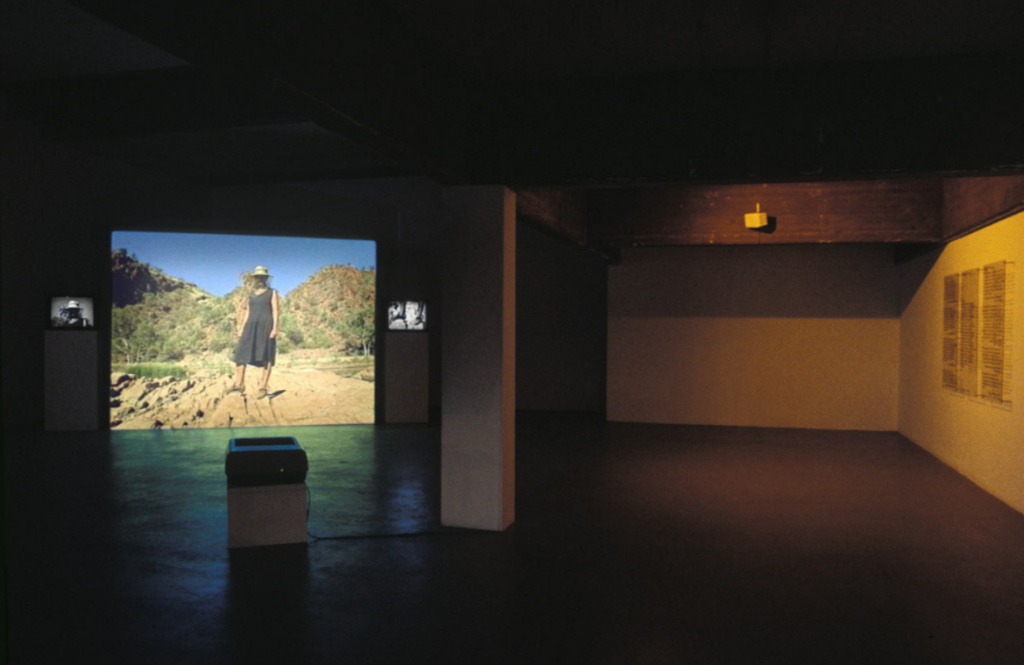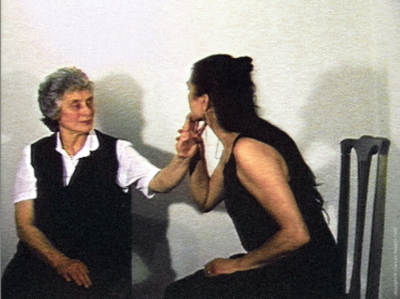Gold, 1993 - restored 2022
In the installation Gold Frances Hegarty frames herself in terrains of contrasting visual impact, which also happen to be within geopolitical territories (Ireland and Australia) linked by emigration and colonisation. She acknowledges the role played by “land” and “landscape” in political cultures and artistic regimes, and confronts her own ambiguous status as an Irishwoman in Australia. In this work, Hegarty politicises the figure of the divided self, a recurrent motif in her work.
For Gold, the installation space is treated as a miniature terrain, with screen and seating blocks planted prominently within it. Across three screens, Hegarty choreographs a series of actions for and with the video camera, devised as ways to engage subjectively with different places. Wide-view scenes on the larger, central screen are flanked by related, close-up sequences to left and right, making the whole array multi-perspectival. The installation sound maintains a sense of fleeting, subjectively experienced detail set against a deeper background of global distances, historical and geological time-spans.
Radical temporal and spatial shifts are intrinsic to Gold. On-screen, primeval rock formations in Australia’s Northern Territories dissolve into the gates and security barriers of 1990s Derry City; a slán, slicing turf from a Donegal peat bog, is followed by the mesmeric scooping of red desert sand. The interrogative nature of Hegarty’s juxtapositions is made plain when she strikes a pose before a rock column in a river bed, whilst to left and right the same self-portrait, with its shadowed face, is digitally scrutinised from head to toe.
Facing the video screens, reflective panels of gold script bear first-hand accounts of Australia from three different perspectives: via the letters of white female transportees and colonists; from Hegarty’s own notebooks; and the diaries of early white male colonists.
Hegarty obviously shares in the cultural memory of British imperialism, a system that recast her Irish forebears, randomly, as the deracinated white colonisers of Australia. Now, as a self-confident diasporic artist passing through that same place, she is irresistibly driven to engage with what is unfamiliar, new and exhilarating to her, even as she imagines possible kinships with both the eighteenth-century Irish transportee, and the First Nation Australian whose culture is so easily elided, in the Western mind, with spectacular nature.
Gold was first exhibited in Relocating History (Fenderesky Gallery, Belfast; Orchard Gallery, Derry; Camerawork, London; all 1993-4). Versions were included in From Beyond the Pale (IMMA 1994) and L’Imaginaire Irlandais (Gallerie des Beaux Arts, Paris, 1996).
Gold was restored in 2022 from the original master tapes, subject to extensive, bespoke digital treatments. The original soundtrack was completely recreated using original 1993 field recordings, remixed and remastered.
Gold has been discussed in depth by art historians including Hilary Robinsion (1995) and Suzanna Chan (1996). See: www.franceshegarty.com/commentary
More at: www.franceshegarty.com and www.franceshegarty.com/art/gold.html
| Medium | Installation with video and sound, for a prepared space |
| Dimensions | Duration: 09:40 min |
| Credit Line | IMMA Collection: Purchase, 2023 |
| Edition | Edition 1/3 |
| Item Number | IMMA.4554 |
| Copyright |
Image © the artist For copyright information, please contact the IMMA Collections team: [email protected]. |
| Tags |


